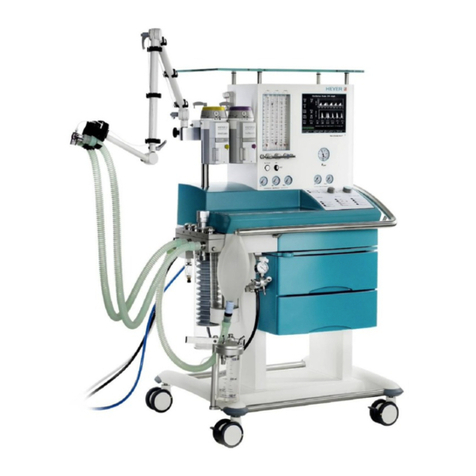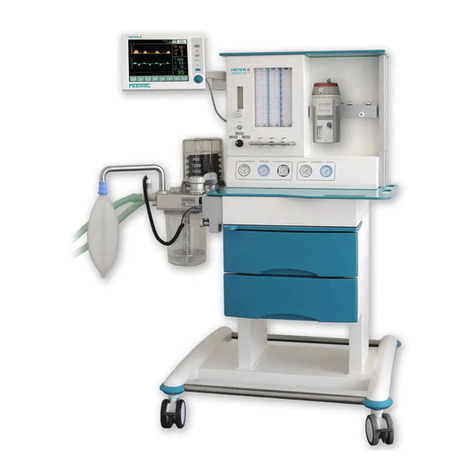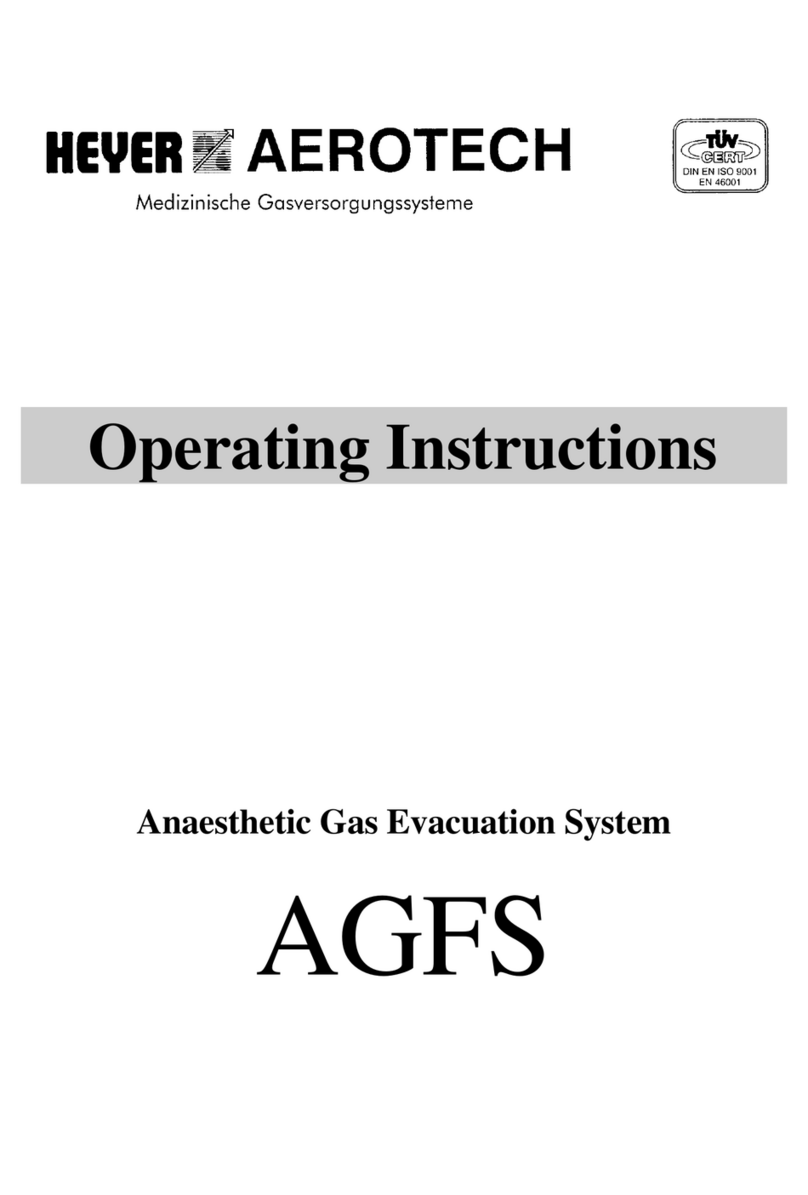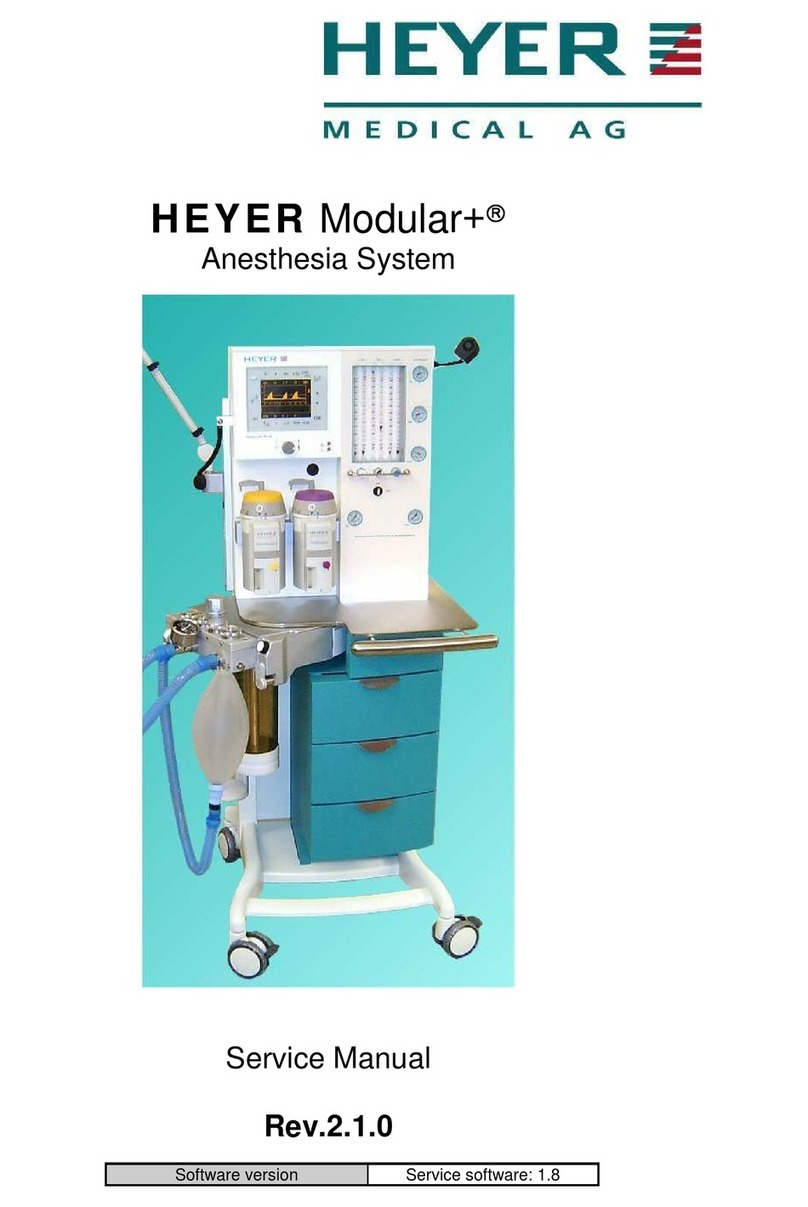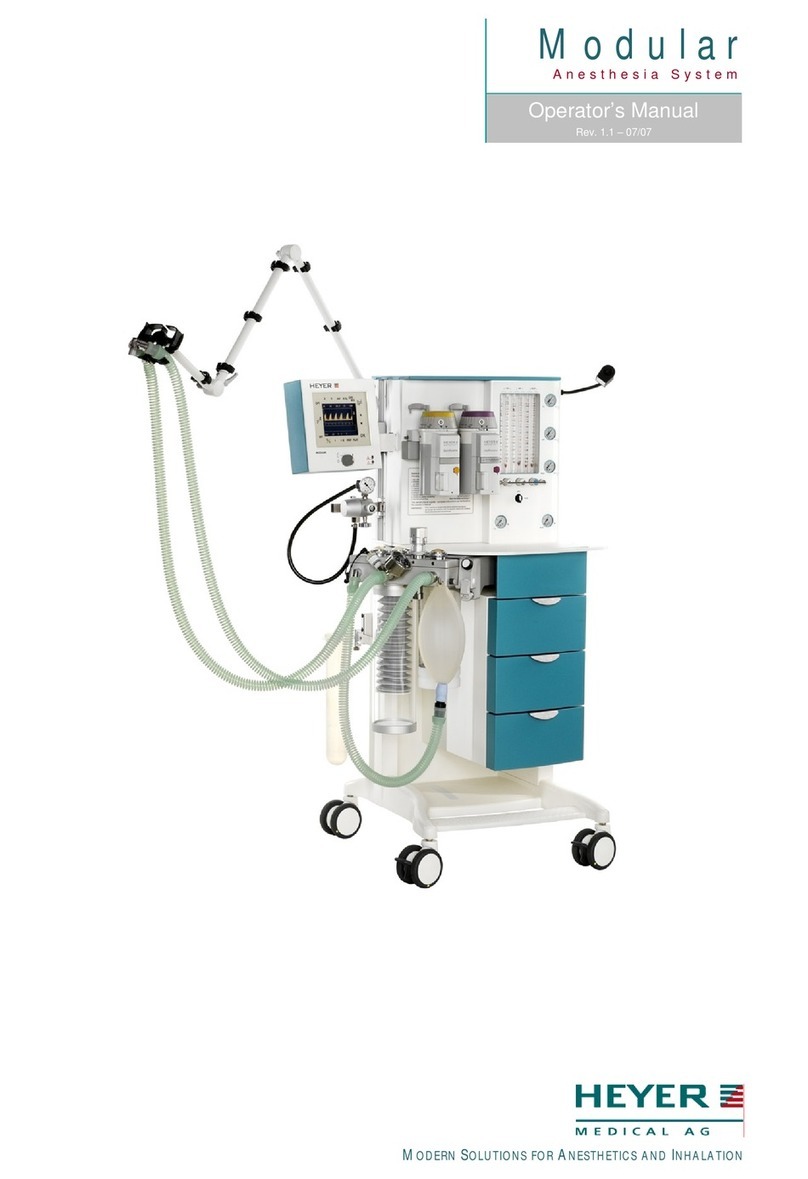Heyer iTernIS ADV User manual

Operator’s Manual
Rev. 1.0 – 07/2011
INNOVATIONS
AS
A
SERVICE
TO
THE
PATIE NT


User’s Instruction Manual
Rev. 1.0 – 07.2011

IMPORTANT
The information contained in this manual is subject to change without notice. The
manufacturer reserves the right to make any changes to the characteristics or the
design.
The use of this equipment on patients needs to be supervised by a specialized
doctor.
Carefully read the instructions contained in this document before connecting the
ventilator to a patient. The information included in this manual is aimed at des-
cribing the ventilator, what it can do and its possible settings, but it cannot, nor
should not be considered as a substitute for the required judgment by competent
professionals, who should decide and determine the mode of use for each patient
in particular.
HEYER Medical AG
Carl-Heyer-Str. 1/3
D-56130 Bad Ems - Germany
Tel.: +49 2603 791-3
Fax: +49 2603 70424
eMail: [email protected]
Internet: www.heyermedical.de

User Instruction Manual | iTernIS ADV i
Table of Contents
1. Introduction................................................................................................. 1.1
1.1 Observed Requirements and Standards ........................................... 1.3
1.2 Equipment Overview.......................................................................... 1.3
1.3 Intended Use...................................................................................... 1.3
1.4 Intended User..................................................................................... 1.3
1.5 Intended Use Environment................................................................. 1.3
1.6 Contraindications for use ................................................................... 1.3
1.7 User support....................................................................................... 1.4
1.8 Symbols used..................................................................................... 1.4
1.9 Abbreviations, acronyms and variable names ................................... 1.6
2. Warnings - Precautions - Notes ................................................................ 2.1
2.1 Denition of Terms ............................................................................ 2.3
2.2 Warnings ............................................................................................ 2.3
2.3 Cautions............................................................................................. 2.4
2.4 Notes.................................................................................................. 2.5
3. Assembly and Installation ......................................................................... 3.1
3.1 Set of Items for Complete Assembly.................................................. 3.3
3.2 Assembly of the Pedestal................................................................... 3.4
3.3 Attachment of Ventilator to the Pedestal............................................ 3.5
3.4 Connection to the Gas Source........................................................... 3.5
3.5 Connection to the Power Source ....................................................... 3.6
3.6 Patient Circuit..................................................................................... 3.7
3.7 O
2 Sensor ......................................................................................... 3.12
4. General Description - Sections of the Ventilator..................................... 4.1
4.1 General Description ........................................................................... 4.3
4.2 Front Panel......................................................................................... 4.3
4.3 Lower Block of Connections............................................................. 4.11
4.4 Rear Panel ....................................................................................... 4.12
4.5 Upper Panel ..................................................................................... 4.12
5. Start-up and Initial Calibration .................................................................. 5.1
5.1 Start-Up.............................................................................................. 5.3
5.2 STAGE 1 - Initial Automatic Control ................................................... 5.3
5.3 STAGE 2 - Patient Category Selection .............................................. 5.3
5.4 STAGE 3 - Tidal Volume (VT) Based on Ideal Body Weight (IBW) ... 5.3
5.5 STAGE 4 - Selection of Humidication System.................................. 5.6
5.6 STAGE 5 - Start Patient Circuit Calibration........................................ 5.6
5.7 STAGE 6 - Calibration in Progress..................................................... 5.8
6. Basic Operations........................................................................................ 6.1
6.1 Overall User Interface Management .................................................. 6.3
6.2 Selecting the Operative Mode............................................................ 6.3
6.3 Conguring the Operative Mode ........................................................ 6.4
6.4 Standby.............................................................................................. 6.7
6.5 Additional Functions........................................................................... 6.7
6.6 Ventilation Parameters..................................................................... 6.10
7. Menu ........................................................................................................... 7.1
7.1 General Information ........................................................................... 7.3

User Instruction Manual | iTernIS ADV
ii
7.2 Patient’s Data..................................................................................... 7.3
7.3 Backup Ventilation.............................................................................. 7.5
7.4 Ventilation Adjuncts............................................................................ 7.6
7.5 Records............................................................................................ 7.11
7.6 Tools................................................................................................. 7.12
7.7 Intra Hospital Transport.................................................................... 7.16
8. Graphics Management............................................................................... 8.1
8.1 Ventilator Screens - [Graphics] Key ................................................... 8.3
8.2 Freeze Screen.................................................................................... 8.6
8.3 Curve Scaling..................................................................................... 8.6
8.4 Autoscale .......................................................................................... 8.6
8.5 Horizontal Axis Position (zero line)..................................................... 8.7
8.6 Reference Loops................................................................................ 8.7
9. ADL/PED Operative Modes........................................................................ 9.1
9.1 VCV - Volume Controlled Ventilation.................................................. 9.3
9.2 PCV - Pressure Controlled Ventilation ............................................... 9.4
9.3 PSV - Pressure Supported Ventilation ............................................... 9.6
9.4 CPAP - Continuous Positive Airway Pressure .................................. 9.8
9.5 SIMV (VCV) + PSV - Synchronized Intermittent Mandatory Ventilation.... 9.8
9.6 SIMV (PCV) + PSV - Synchronized Intermittent Mandatory Ventilation .. 9.10
9.7 MMV with PSV - Mandatory Minute Ventilation with Pressure Supported
Ventilation ................................................................................................ 9.11
9.8 PSV with Assured VT....................................................................... 9.13
9.9 APRV - Airway Pressure Release Ventilation .................................. 9.14
9.10 NIV - Noninvasive Ventilation........................................................... 9.16
9.11 PRVC - Pressure-Regulated, Volume-Controlled Ventilation........... 9.17
9.12 Backup Ventilation............................................................................ 9.19
10. NEO-INF Operative Modes..................................................................... 10.1
10.1 VCV - Volume Controlled Ventilation................................................ 10.3
10.2 PCV - Pressure Controlled Ventilation ............................................. 10.4
10.3 PSV/CPAP - Pressure Supported Ventilation / CPAP ...................... 10.5
10.4 SIMV (VCV) + PSV - Synchronized Intermittent Mandatory Ventilation ... 10.6
10.5 SIMV (PCV) + PSV - Synchronized Intermittent Mandatory Ventilation .... 10.8
10.6 APRV - Airway Pressure Release Ventilation .................................. 10.9
10.7 TCPL - Time-Cycled, Pressure-Limited Ventilation ........................ 10.10
10.8 SIMV (TCPL) + PSV - Synchronized Intermittent Mandatory Ventilation.. 10.11
10.9 CPAP Continuous Flow.................................................................. 10.12
10.10 PRVC - Pressure-regulated, Volume-controlled Ventilation.......... 10.13
10.11 Backup Ventilation ........................................................................ 10.15
11. Alarms...................................................................................................... 11.1
11.1 General Characteristics .................................................................. 11.3
11.2 Alarm Events Record ....................................................................... 11.3
11.3 Alarm Signals................................................................................... 11.4
11.4 Audio Paused 30/60 s...................................................................... 11.6
11.5 Alarm Limit Adjustment .................................................................... 11.6
11.6 Inop. Vent. Alarm (Inoperative Ventilator) ........................................ 11.8
11.7 High Priority Alarms.......................................................................... 11.9
11.8 Medium Priority Alarms .................................................................. 11.10
11.9 Low Priority Alarms .........................................................................11.11
12. Respiratory Mechanics ........................................................................ 12.1
12.1 auto-PEEP ....................................................................................... 12.3

User Instruction Manual | iTernIS ADV iii
12.2 Compliance and Resistance ............................................................ 12.4
12.3 Trapped Volume............................................................................... 12.6
12.4 Slow Vital Capacity .......................................................................... 12.7
12.5 P0.1.................................................................................................. 12.8
12.6 PV ex (Inection Points).................................................................. 12.10
12.7 Pimáx ................................................................................................ 12.11
12.8 VD/VT Physiologic ......................................................................... 12.13
13. Trends...................................................................................................... 13.1
13.1 General Description ......................................................................... 13.3
13.2 Access to Trends.............................................................................. 13.4
13.3 Conguration.................................................................................... 13.4
13.4 Trend Curves Management ............................................................. 13.5
14. Capnography .......................................................................................... 14.1
14.1 Capnograph ..................................................................................... 14.3
14.2 Connection of the Capnograph ....................................................... 14.4
14.3 Monitoring ........................................................................................ 14.4
14.4 Capnography Menu.......................................................................... 14.5
14.5 Messages......................................................................................... 14.6
15. Operational Verication ......................................................................... 15.1
15.1 Necessary Items .............................................................................. 15.3
15.2 Ventilator Preparation....................................................................... 15.3
15.3 Functional Verication...................................................................... 15.3
15.4 Alarms Verication ........................................................................... 15.4
15.5 Operative Verication....................................................................... 15.5
16. Cleaning and Maintenance .................................................................... 16.1
16.1 Cleaning and Sterilization ............................................................... 16.3
16.2 Assembly of the Patient Circuit ........................................................ 16.5
16.3 Maintenance..................................................................................... 16.6
16.4 Periodical Safety-Related Controls.................................................. 16.8
17. Technical Specications........................................................................ 17.1
17.1 Classication .................................................................................... 17.3
17.2 Physical Characteristics................................................................... 17.3
17.3 Screen.............................................................................................. 17.3
17.4 Environmental Requirements.......................................................... .17.3
17.5 Pneumatic Specications ................................................................. 17.3
17.6 Electrical Specications ................................................................... 17.4
17.7 Ventilatory Parameter Adjustments.................................................. 17.4
17.8 Monitored Parameters...................................................................... 17.6
17.9 Alarm Adjustment............................................................................. 17.6
17.10 Data Collection for Control and Monitoring..................................... 17.7
17.11 Electromagnetic Compatibility......................................................... 17.7
17.12 Basic Operation of the Ventilator .................................................. 17.10
17.13 Safety Mechanisms ...................................................................... 17.11
17.14 Diagram of the Pneumatic Circuit of the Ventilator ....................... 17.13
17.15 Lifetime ......................................................................................... 17.14
Appendices ......................................................................................................A.i
Warranty ...........................................................................................................G.i
Alphabetical Index............................................................................................ I.i

User Instruction Manual | iTernIS ADV
iv
Table 3-1 Set of Items for Complete Assembly..................................................3.3
Table 4-1 Electric power source light indicators............................................... 4.11
Table 5-1 Change Increases According to the Current IBW Value ....................5.3
Table 5-2 Ideal Body Weight - Women ..............................................................5.5
Table 5-3 Ideal Body Weight - Men ...................................................................5.5
Table 7-1 Details of Parameters in Patient Information......................................7.4
Table 7-2 Requirement of Backup Ventilation Setting According to the Operative
Mode..................................................................................................7.5
Table 7-3 Leakage compensation (in L/min) ...................................................7.11
Table 7-4 Suction Conguration.......................................................................7.13
Table 7-5 Atmospheric Standard .....................................................................7.15
Table 9-1 Managing the Inspiratory Phase in PSV with Assured VT ...............9.13
Table 11-1 Colors and Flashing Frequency Based on Priority.........................11.4
Table 11-2 Light Indicators ............................................................................... 11.4
Table 11-3 Auditory Signal ............................................................................... 11.5
Table 11-4 Maintained Visual Light Signal - Alarm Signals ..............................11.5
Table 11-5 Auditory Signal (Non-Maintained)...................................................11.6
Table 11-6 Inop. Vent. Alarm signals................................................................ 11.9
Table 11-7 High Priority Alarms .......................................................................11.9
Table 11-8 Medium Priority Alarms ................................................................11.10
Table 11-9 Low Priority Alarms....................................................................... 11.11
Table 15-1 Functional Verication....................................................................15.4
Table 15-2 Alarm Verication ...........................................................................15.5
Table 16-1 Suggested Preventive Maintenance ..............................................16.6
Table 17-1 Ventilator Classications ................................................................17.3
Table 17-2 Physical Characteristics .................................................................17.3
Table 17-3 Screen............................................................................................17.3
Table 17-4 Environmental Requirements.........................................................17.3
Table 17-5 Pneumatic Specications...............................................................17.3
Table 17-6 Electrical Specications .................................................................17.4
Table 17-7 Ventilation Parameter Adjustment ..................................................17.4
Table 17-8 Monitored Parameters ...................................................................17.6
Table 17-9 Alarm Adjustment ...........................................................................17.6
Table 17-10 Data Collection for Control and Monitoring ..................................17.7
Table 17-11 Electromagnetic Emissions Statement ........................................17.8
Table 17-12 Electromagnetic Immunity Statement ..........................................17.8
Table 17-13 Electromagnetic Immunity Statement .........................................17.9
Table Index

User Instruction Manual | iTernIS ADV v
Table 17-14 Recommended Separation Distances between the Ventilator and
Mobile/Portable Communications Equipment ...............................17.10
Table 17-15 Ventilation Parameters in Emergency Ventilation .....................17.12
Table 17-16 Lifetime.......................................................................................17.14

User Instruction Manual | iTernIS ADV
vi
This Page Left Intentionally Blank

Introduction | iTernIS ADV 1. 1
CHAPTER CONTENTS
1.1 Observed requirements and standards
1.2 Equipment overview
1.3 Intended use
1.4 Intended user
1.5 Intended use environment
1.6 Contraindications for use
1.7 User support
1.8 Symbols used
1.9 Abbreviations, acronyms and variable names
Introduction
1
CHAPTER SUMMARY
This introductory chapter details the concepts dening iTernIS ADV. These deni-
tions provide information about the equipment, and its appropriate use. The infor-
mation included in this chapter is to be used as mandatory guidelines for the design
and development of iTernIS ADV.

Introduction | iTernIS ADV
1. 2
This Page Left Intentionally Blank

Introduction | iTernIS ADV 1. 3
• UNE-EN 794-1:1997+A1:2001+A2:2009. Lung ventilators -- Part 1: Particular re-
quirements for critical care ventilators.
• IEC 60601-1:2005. Medical electrical equipment -- Part 1: General requirements for
basic safety and essential performance.
• IEC 60601-1-2:2001+A1:2004. Medical electrical equipment -- Part 1-2: General
requirements for basic safety and essential performance - Collateral standard:
Electromagnetic compatibility - Requirements and tests.
• IEC 60601-1-4:1997+A1:2000. Medical electrical equipment -- Part 1-4: General
requirements for safety - Collateral standard: Programmable electrical medical sys-
tems.
• UNE-EN 60601-1-8:2008. Medical electrical equipment -- Part 1-8: General requi-
rements for basic safety and essential performance - Collateral Standard: General
requirements, tests and guidance for alarm systems in medical electrical equipment
and medical electrical systems.
• IEC 60601-2-12:2001. Medical electrical equipment -- Part 2-12: Particular require-
ments for the safety of lung ventilators - Critical care ventilators.
• UNE-EN 980:2008. Graphical symbols for use in the labeling of medical devices.
• ISO 13406-2 Class II. Ergonomic requirements for work with visual displays based
on at panels -- Part 2: Ergonomic requirements for at panel displays
iTernIS ADV is a microprocessor-controlled mechanical ventilator which incorpo-
rates the most advanced methods for ventilatory support. The electronic circuit
operates two proportional valves which provide the gas ow necessary to satisfy
the selected conguration.
The iTernIS ADV ventilator was designed to be used with all types of patients:
adult, pediatric, and neonatal infants requiring invasive and noninvasive ventilatory
support, for a short or long period, allowing monitoring of the main ventilatory pa-
rameters. The equipment provides care for patients able or unable to make their
own breathing efforts.
iTernIS ADV must be managed by or under the supervision of health professionals
with the appropriate training in ventilatory therapies, and especially in the use of
this ventilator.
The ventilator was designed to be used in hospitals and health care centers, speci-
cally in intensive care wards, where the presence of competent professionals and
of the required facilities ensure the proper use of the equipment
It is NOT possible to use a ventilator when any of the following events occurs:
• Starting and operating the ventilator in the absence of competent medical profes-
sionals supervising the procedure.
1.1 | Observed
Requirements and
Standards
1.2 | General Equipment
Overview
1.3 | Intended Use
1.4 | Intended User
1.5 | Intended Use
Environment
1.6 | Contraindications
for Use

Introduction | iTernIS ADV
1. 4
• If there is no alternative ventilation method and equipment that can be used as a
backup.
• To drive an anesthesia machine. Never use it in the presence of ammable anes-
thetic gases.
• Connected the device to an inadequate electric mains power (e.g. without earth
connection).
• The ventilator is located in the vicinity of magnetic resonance equipment or signi-
cant sources of electromagnetic radiation.
• With gas supply which do not meet medical grade specications.
• During the inter hospital transfer of patients (mobilization outside the assigned
institution).
• Failure to strictly comply with the instructions for use, user and intended use en-
vironment for this ventilator.
If you need technical support, please send an email to service@heyermedical.de.
Please be sure to include the name of the institution to which the equipment belongs,
and the contact details where a response can be submitted.
Keep upwards.
Keep dry.
Temperature limits.
Fragile.
Do not stack more than 5 boxes.
Moisture limit.
Manufacturer.
Not reusable.
Marking indicating compliance with the re-
quirements of European Council Directive
(93/42/EEC) on medical devices.
1.7 | User Support
1.8 | Symbols Used

Introduction | iTernIS ADV 1. 5
Type B applied part
Degree of protection against ingress of par-
ticles (N1) and liquids (N2). IP Classica-
tion.
Access to alarm limit conguration.
Audio paused. Icon used to identify the
control and the on-screen warning of the
paused sound alarm signal.
Alarm off. Icon indicating that an alarm has
been deactivated.
Alarm limits.
Exhaled gas discharge port (from patient).
Connection for the expiration set.
Inhaled gas delivery port (to patient).
Connection port for the nebulizer.
P1 P2 Connection ports for the distal pneumota-
chograph hoses.
Prox Connection port for the proximal pneumo-
tachograph.
O2%Connection port for the O2cell.
Authorized representative in the European
Community.
Off (electric power).
On (electric power).
Warning
Caution
Note

Introduction | iTernIS ADV
1. 6
Ventilator in Standby. There is no ventila-
tion support in this state.
Indicates patient-initiated breaths.
States of charge of the internal battery.
Rise Time. Control for the setting speed of
the congured inspiratory pressure.
On-screen display for enabled autoscale.
On-screen display for screenshot in pro-
gress.
On-screen display for nebulization on.
On-screen display for [Ctrl] key pressed.
On-screen display for passive humidier
selected.
On-screen display for active humidier se-
lected.
Screen lock.
Proximal pneumotachograph activated.
On-screen display for maintenance requi-
red.
%O2Concentration of O2
ADL Adult
APRV Airway pressure release ventilation
Cdin Dynamic compliance
Cest Static compliance
1.9 | Abbreviations,
Acronyms and
Variable Names

Introduction | iTernIS ADV 1. 7
Cmax Maximum compliance
CPAP Continuous positive airway pressure
Esc Escape
Esp. Expiration or expired
ETCO2Expiration-end CO2
fRespiratory rate
F Espon Spontaneous respiratory rate
F/VT Respiratory rate:tidal volume ratio
FiO2Inspired oxygen fraction
fTOTAL Total respiratory rate
I:E Inspiratory time:expiratory time ratio
Insp. Inspiration or inspired
Lip Upper inection point
MMV Mandatory minute ventilation
NEO-INF Neonate-Infant
O2100% 100% oxygenation
P/V ex Inection points
P0.1 Pressure during the rst 100 ms
P1 Lower hose inlet of expiratory pneu-
motachograph
P2 Upper hose inlet of expiratory pneu-
motachograph
Paw Airway pressure
PCV Pressure controlled ventilation
PED Pediatric
PEEP Positive end expiratory pressure
Pimax Maximum inspiratory pressure

Introduction | iTernIS ADV
1. 8
Pmax Maximum pressure
Pmin Minimum pressure
PSV Pressure support ventilation
Re Expiratory resistance
Ri Inspiratory resistance
SIMV Synchronized intermittent mandatory
ventilation
TCPL Time-cycled, pressure-limited ventila-
tion
Te Expiratory time
Ti Inspiratory time
Uip Upper inection point
VFlow
VCO2Eliminated CO2
VCV Volume control ventilation
VE Expired minute volume
VE Espont Spontaneous expiratory minute volu-
me
VE Mandat Mandatory expired minute volume
VM Minute volume
Vmax Maximum volume
NIV Noninvasive ventilation
VT or VTTidal volume
WOBi Imposed work of breathing

Warnings - Precautions - Notes | iTernIS ADV 2. 1
Warnings - Precautions - Notes
CHAPTER CONTENTS
2.1 Denition of Terms
2.2 Warnings
2.3 Precautions
2.4 Notes
2
CHAPTER SUMMARY
Warnings, precautions and notes are used to highlight relevant information that the
reader must know. This chapter denes the meaning of the terms warning, caution,
and note in the context of this manual, and summarizes some of the most important
denitions of each of them.

Warnings - Precautions - Notes | iTernIS ADV
2. 2
This Page Left Intentionally Blank
Table of contents
Other Heyer Medical Equipment manuals
Popular Medical Equipment manuals by other brands

Getinge
Getinge Arjohuntleigh Nimbus 3 Professional Instructions for use

Mettler Electronics
Mettler Electronics Sonicator 730 Maintenance manual

Pressalit Care
Pressalit Care R1100 Mounting instruction

Denas MS
Denas MS DENAS-T operating manual

bort medical
bort medical ActiveColor quick guide

AccuVein
AccuVein AV400 user manual
